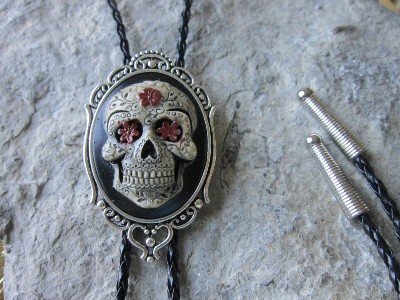Affiliate Disclaimer: We work to provide bolo ties and locate merchants who sell the products you are looking for. If you make a purchase from any of the merchants we endorse, we will earn a small commission at no additional cost to you. Thank you for your support!
Day of the Dead Bolo Tie [Honoring Lost Loved Ones: The Significance of Mexico's Day of the Dead]

Introduction to Day of the Dead
Of all Mexico's renowned festivals and celebrations, there is none more fascinating than Día de Los Muertos, or Day of the Dead. Far from a morbid occasion, this holiday focuses on remembrance and paying tribute to deceased friends and family members. It encapsulates the Mexican spirit of honoring both life and death.
When and How It's Celebrated
Día de Los Muertos takes place annually on November 1st and 2nd. The festivities begin well before then, often with community gatherings to clean and decorate gravesites. Vibrant marigolds known as cempasúchil and papel picado streamers adorn altars, graves, and public spaces. These symbols guide the spirits back to visit the living.
The iconic element of Día de Los Muertos is the calavera (skull) imagery that fills every corner. From sugar candy skulls to skull masks and face painting, it is a way to poke fun at death itself. Other offerings left as gifts for returning souls include tequila, cigarettes, and the deceased's favorite foods.
Honoring the Dead and Celebrating Life
While it coincides with Halloween and All Saints Day, Día de Los Muertos is far more about celebrating life than fearing death. Family gatherings are joyous reunions where memories are shared. The souls of children are particularly honored on November 1st, while November 2nd is for adults. Though deeply rooted in indigenous Aztec rituals, the modern version is an eclectic mix of ancient and Catholic traditions.
Sweet Symbols - The Artistry of Mexican Sugar Skulls
Among the most iconic elements of Mexico's Day of the Dead are the colorful sugar skulls prominently displayed everywhere during the festivities. Known as calaveras de azúcar, these skulls are far from frightening. Instead, they capture the holiday's spirit of honoring deceased loved ones with joy and humor.
Sugar skull making dates back to the 17th century. They were originally made from a mixture of clay and ash. With vibrant flowers, feathers, beads, and glitter, each sugar skull is edible folk art, customized to represent a particular deceased soul. The name of the honored individual is often written across the forehead.
Modern calaveras de azúcar are elaborately decorated with royal icing, tin foil, and sequins, transforming them into dazzling works of art. Large skulls adorn altars and graves, while small skulls are given as gifts. Their sweetness shows death doesn't have to be bitter.
Sugar skulls come in a range of colors and designs, from the traditional to the modern whimsical. Yellow and purple represent Mexico, while other colors have symbolic meaning - red for life, white for hope, pink for celebration. New trends add motifs like hearts, birds, and butterflies. During Día de Los Muertos, sugar skulls remind us that death is sweet, not scary. They honor past lives with edible offerings that feed the soul. These skulls may be gone in a bite, but their memory lingers as a symbol of devotion.
Significance of Day of the Dead Collectibles
The colorful artwork and symbols associated with Día de Los Muertos make for an extensive array of creative collectibles. Intricately decorated sugar skulls are the most iconic. Figurines of skeletons engaged in everyday activities are also prevalent. Vibrant Mexican folk art inspired by the holiday is highly collectible too.
The allure of these collectibles extends beyond Mexico, with their unique designs and rich symbolism having universal appeal. Owning a piece represents honoring past generations. Day of the Dead collectibles make perfect gifts as well.
Conclusion
With stunning artwork that playfully mocks death, Día de Los Muertos collectibles remind us to embrace life while remembering loved ones now gone. Their beauty and craftsmanship keep Mexican customs alive.

Day of Dead Bolo Ties
References
History Channel - Day of the DeadNational Geographic - Day of the Dead Traditions
Smithsonian Magazine - What Dia de los Muertos Means to Mexicans
Britannica - Day of the Dead
Los Angeles Times - Mexico's Day of the Dead
Mexican Sugar Skull - History of Sugar Skulls
Day of the Dead Holiday - Sugar Skulls
Folk Art Museum - Sugar Skull Folk Art
National Museum of Mexican Art
Michaels - How to Make Mexican Sugar Skulls
Meaning of Sugar Skull Colors


